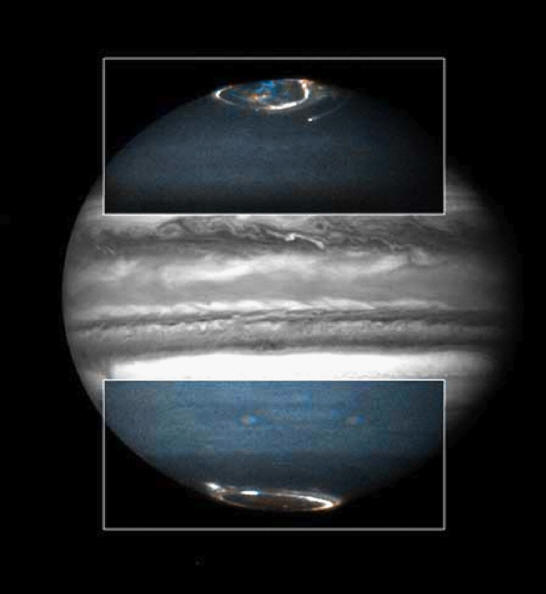|

Combined Hubble camera images of
Jupiter's polar aurorae.
Credit: NASA, ESA, and the Hubble
Heritage Team (STScI/AURA)
Jove's Glowing Mantle
Aug
11, 2011
Jupiter puts on a periodic
light show.
Several years ago, Picture of the
Day articles discussed the so-called
"volcanic" plumes erupting from
Jupiter's moon Io. It was argued
that they are plasma discharges from
the moon electrically connected to
the giant planet. Some astronomers
acknowledged the electrical
connection when Io's electromagnetic
"footprint" was seen in Jupiter's
polar aurora. Later, it was found
that
all four of Jupiter’s
large moons leave their imprints in
the aurora.
When NASA launched the New
Horizons spacecraft on a mission to
study Pluto and Charon, they trained
its cameras on Jupiter's environment
as it flew by in order to test their
resolution. The “plumes” of Tvashtar,
one of Io's "volcanoes," were seen
by the itinerant spacecraft to be
filamentary, indicating that they
are corona arc discharges from the
electric “hot spots” linking Io with
Jupiter.
According to a recent
press release, Jupiter's
aurorae are becoming more active,
with bursts of extreme ultraviolet
light detected. The research paper's
authors attribute the auroral flares
to "...pulsed reconnections of the
magnetic field at the planet's
dayside magnetopause..."
An electrical interaction between
Jupiter and its moons means that
they are charged bodies and are not
electrically neutral. Jupiter exists
in a dynamic electrical relationship
to the Sun and it is now known that
charged particles from the Sun power
the planetary aurorae.
Earth possesses an electrically
active magnetotail (or plasma tail),
extending for millions of
kilometers, always pointed away from
the Sun. Streams of charged
particles from the Sun (the solar
wind) are captured by the
magnetosphere, collecting in a
plasma sheet within the magnetotail,
where they are held together by
Earth's magnetic field. The same
structural factors doubtless govern
Jupiter's magnetosphere.
The light bursts from Jupiter's
aurorae are said to be the result of
"magnetic reconnection" events. The
solar wind is said to "stretch" its
magnetic field like a rubber band.
When it "snaps back" the
over-stretched magnetic field lines
explode, converting some of the
"magnetic energy" to heat and light.
As was discussed in a
previous Picture of the
Day, how that energy is released is
not known. It seems, though, that
space scientists are reversing cause
(electric currents) and effect
(magnetic fields). They downplay or
deny the importance of electrical
processes.
Retired Professor of Electrical
Engineering
Don Scott's admonitions
about magnetic reconnection should
be kept in mind when the
electromagnetic nature of aurorae,
in general, is invoked:
1. Magnetic field lines are only
convenient concepts, nothing more.
They are not loci or contours of
constant magnetic flux density
(field strength). They just indicate
the field’s direction. In regions
where they are close together the
field is stronger than where they
are widely separated.
2. Therefore, sketching magnetic
field lines can help us visualize
the shape and strength of magnetic
fields. They can help us to sketch
the net result (vector sum) if and
when two or more fields interact
(are superimposed on each other).
3. We can only draw magnetic
field lines (in cases not involving
permanent ferromagnetic magnets) by
considering the electric currents
that create those fields.
4. Magnetic lines of force do not
actually exist in three-dimensional
space anymore than lines of latitude
or longitude do.
5. If a field changes from one
instant to another, we cannot use
"streaming video" to watch a given
line move and change shape. This is
because we must redraw a complete
set of lines at each instant. It
isn’t the same line that has moved
it is the field that has changed.
The two sets of lines describe the
field at those two different times.
6. Magnetic lines of force do not
move any more than lines of
longitude do. A determined
unwillingness to recognize this fact
has led to the idea that lines can
move toward each other, touch,
merge, and then release energy. This
last notion, if applied to circles
of longitude that come together and
"merge" at Earth’s poles, could be
proposed as causing gravitational
energy releases at those locations.
There is no such process as
"magnetic merging" or "reconnection"
of magnetic field lines in the real
world.
Stephen Smith
Hat tip to Anne Klinkner
 New
DVD New
DVD
The Lightning-Scarred
Planet Mars
A video documentary that could
change everything you thought you
knew about ancient times and
symbols. In this second episode of
Symbols of an Alien Sky, David
Talbott takes the viewer on an
odyssey across the surface of Mars.
Exploring feature after feature of
the planet, he finds that only
electric arcs could produce the
observed patterns. The high
resolution images reveal massive
channels and gouges, great mounds,
and crater chains, none finding an
explanation in traditional geology,
but all matching the scars from
electric discharge experiments in
the laboratory. (Approximately 85
minutes)
Video Selections
Order Link
|





 New
DVD
New
DVD

